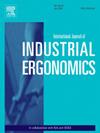A novel biomechanical model for predicting ankle moments and assessing static balance in users of shoulder-support exoskeletons
IF 2.5
2区 工程技术
Q2 ENGINEERING, INDUSTRIAL
International Journal of Industrial Ergonomics
Pub Date : 2025-01-01
DOI:10.1016/j.ergon.2024.103688
引用次数: 0
Abstract
Shoulder work-related musculoskeletal disorders (WMSDs) pose significant challenges, leading to substantial economic burdens and negatively impacting worker well-being. Shoulder-support exoskeletons have emerged as a promising solution to prevent shoulder WMSDs by providing ergonomic support to workers. However, the exoskeletons may restrict joint motion and affect the user balance, necessitating a thorough understanding of balance effects during the exoskeleton design and evaluation process. Currently, the absence of a balance prediction model for the shoulder-support exoskeleton users poses challenges in incorporating balance considerations into the early design stages. To fill this gap, this study proposes a novel biomechanical model to assess static balance by predicting ankle moment changes in shoulder-support exoskeleton users. Our model integrates principles from the Stiff Rod Inverted Pendulum model and introduces a novel function to compute the ankle moment resulting from exoskeleton reaction forces. The model's performance was validated by comparing it with experimental data and a widely used commercial benchmark software, the 3D Static Strength Prediction Program (3DSSPP). Follow-up experimental validation demonstrated that the model predicted ankle moments closely aligned with the measured body sway and subjective instability ratings. Strong correlations were observed between the predicted ankle moment and subjective instability ratings. The mean difference between predicted ankle moments of the proposed model and those of the 3DSSPP in the no-exoskeleton condition was less than 1.15%. These findings indicate that the proposed model offers valuable insights to facilitate the design and evaluation of exoskeletons for improved static balance.
用于预测肩部支撑外骨骼使用者踝关节力矩和评估静态平衡的新型生物力学模型
与工作有关的肩部肌肉骨骼疾病(WMSDs)是一项重大挑战,不仅会造成巨大的经济负担,还会对工人的健康产生负面影响。肩部支撑外骨骼通过为工人提供符合人体工程学的支撑,已成为预防肩部肌肉骨骼疾病的一种有前途的解决方案。然而,外骨骼可能会限制关节运动并影响使用者的平衡,因此有必要在外骨骼设计和评估过程中全面了解平衡效应。目前,由于缺乏针对肩部支撑外骨骼使用者的平衡预测模型,将平衡因素纳入早期设计阶段面临挑战。为了填补这一空白,本研究提出了一种新型生物力学模型,通过预测肩部支撑外骨骼使用者的踝关节力矩变化来评估静态平衡。我们的模型整合了刚性杆倒立摆模型的原理,并引入了一个新函数来计算外骨骼反作用力产生的踝关节力矩。通过与实验数据和广泛使用的商业基准软件三维静态强度预测程序(3DSSPP)进行比较,对模型的性能进行了验证。后续的实验验证表明,该模型预测的踝关节力矩与测量的身体摇摆和主观不稳定性评级密切吻合。在预测的踝关节力矩和主观不稳定性评级之间观察到了很强的相关性。在无外骨架条件下,拟议模型预测的踝关节力矩与 3DSSPP 预测的踝关节力矩之间的平均差异小于 1.15%。这些研究结果表明,所提出的模型为促进设计和评估外骨骼以改善静态平衡提供了有价值的见解。
本文章由计算机程序翻译,如有差异,请以英文原文为准。
求助全文
约1分钟内获得全文
求助全文
来源期刊
CiteScore
6.40
自引率
12.90%
发文量
110
审稿时长
56 days
期刊介绍:
The journal publishes original contributions that add to our understanding of the role of humans in today systems and the interactions thereof with various system components. The journal typically covers the following areas: industrial and occupational ergonomics, design of systems, tools and equipment, human performance measurement and modeling, human productivity, humans in technologically complex systems, and safety. The focus of the articles includes basic theoretical advances, applications, case studies, new methodologies and procedures; and empirical studies.

 求助内容:
求助内容: 应助结果提醒方式:
应助结果提醒方式:


